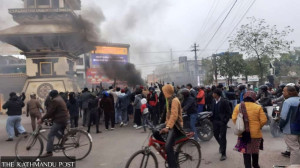National
Feasibility study of Nepal-China railway on track, department says
Aerial survey and mapping are likely to be completed within this month, according to Rohit Bisural, director general at the railway department.
Prithvi Man Shrestha
The Chinese technical team is expected to complete an aerial survey of the proposed Kerung-Kathmandu Cross Border Railway within this month as the fieldwork progresses smoothly, a senior official at the Department of Railways said.
As a part of the long-delayed detailed feasibility study, the task of aerial survey has been conducted since early this year, according to the department. The Chinese technical team has been undertaking a detailed feasibility study, which is supposed to be completed within 42 months of its start. China has approved a grant assistance of RMB 180 million (Rs3.35 billion) for the purpose, according to the department.
“Since the Chinese team started conducting an aerial survey using drones in March this year, the task has been completed in Nuwakot and Rasuwa districts,” said Rohit Bisural, director general at the railway department.
“The process of obtaining necessary approval for the survey to conduct the aerial survey in Kathmandu continues and is expected to be completed within this month as there is not much territory to be covered by the proposed railway.”
According to Bisural, work on a detailed feasibility study is on track. “Our plan was to complete the aerial survey and mapping within 2023, which is expected to be achieved,” he added.
Geological survey and mapping, spatial technical studies, on-site surveying and mapping, geological survey, construction condition studies, engineering studies, and preparation of the feasibility study report are other tasks under the detailed feasibility study, according to the department.
“Geological survey will begin next year and the remaining tasks are expected to be completed within the 42-month deadline,” said Bisural.
In late November, talks between Nepal and China were held at Xiantao, China, to review the progress of the cross-border railway project. “Both sides expressed satisfaction at the progress in the feasibility study,” Bisural said. Keshav Kumar Sharma, secretary at the Ministry of Physical Infrastructure and Transport, led the Nepali delegation at the talks.
Before the feasibility study task began, a Chinese technical team representing the China Railway First Survey and Design Institute Group visited Nepal in late December last year and conducted a reconnaissance survey of the railway project, according to the railway department.
Reconnaissance is the first engineering survey in a previously unsurveyed territory for the purpose of project implementation. The detailed feasibility study began only in March this year, the department said.
It has been several years since the country’s political leaders started selling the dream of cross-border railways. But it took longer than expected even to start the survey.
Many analysts consider a railway connecting the Chinese border town of Kerung with Kathmandu as an effort to counter India’s project to connect the Nepali capital with a cross-border Railway via Raxaul.
When Prime Minister Pushpa Kamal Dahal visited India in late May and early June, the Indian side had handed over a draft of the Final Location Survey, of the proposed cross-border Raxaul-Kathmandu railway to the Nepali authorities. According to the department officials, the Final Location Survey is also a type of detailed feasibility study.
Even though talks about building the Kerung-Kathmandu railway began earlier than the Raxaul-Kathmandu project, the feasibility study of the northern connection began much later because of Covid-19 and China’s strict anti-pandemic efforts.
China got into developing railways in Nepal when former prime minister KP Sharma Oli visited Beijing in March 2016 during his first stint as prime minister.
Just out of India’s trade blockade, Nepal sought to develop alternative transport routes, citing the country’s overdependence on its southern neighbour.
Nepal and China then had agreed that the two sides would exchange ideas and proposals on constructing cross-border railways and railway networks in Nepal and support enterprises to start related preparatory work as soon as possible.
The Chinese then sent their technical teams to conduct a preliminary feasibility study for the proposed railway in November 2017 and May 2018.
An MoU was signed between the two countries on 21 June 2018 on the Cooperation in Railway Project when Oli visited China during his second stint as prime minister. Recalling the MoU, the two sides agreed to conduct the feasibility study as outlined in the MoU when Chinese President Xi Jinping visited Nepal in October 2019. The study would lay the foundation for the cross-border railway.
However, the feasibility study could not move ahead instantly because of the Covid-19 pandemic. China sent its technical team to conduct a reconnaissance survey in December last year and another team early this year for the feasibility study.
However, building this railway will not be easy from both technical and financial perspectives because of the rough terrain and environmental sensitivity.
According to a pre-feasibility study, 95 percent of the 73-km railway network will need tunnelling. Its construction cost is estimated at Rs293 billion, according to Bisural. There are also concerns over whether the project is financially viable for Nepal.
Speaking at an event organised on Tuesday by the Centre for Social Inclusion and Federalism (CESIF), a think tank, on Nepal-China relations and Prime Minister Pushpa Kamal Dahal’s recent visit to China, experts stressed the need to focus more on road connectivity than railway, citing the geographical and engineering challenges associated with railway development.
Former minister and Nepali Congress leader Minendra Rijal questioned the very rationale of bringing Chinese rail to Kathmandu. “What will we export to China and what will we import from Tibet through the railroad? So let’s build roads instead.”




 5.78°C Kathmandu
5.78°C Kathmandu







%20(1).jpg&w=300&height=200)







